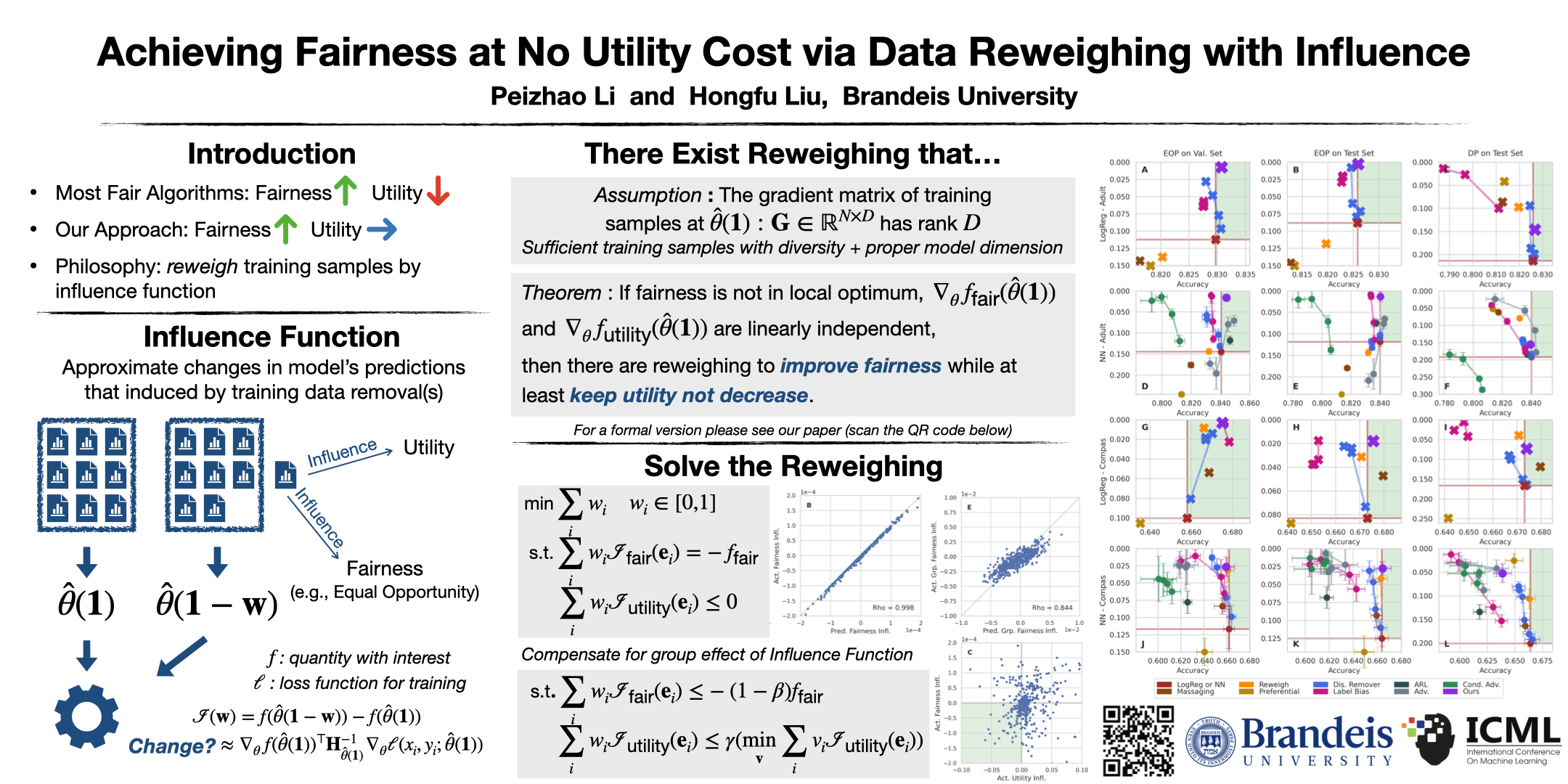Code for ICML 2022 paper: Achieving Fairness at No Utility Cost via Data Reweighing with Influence.
https://proceedings.mlr.press/v162/li22p/li22p.pdf
Please consider citing our paper if you find our research helpful :)
@InProceedings{pmlr-v162-li22p,
title = {Achieving Fairness at No Utility Cost via Data Reweighing with Influence},
author = {Li, Peizhao and Liu, Hongfu},
booktitle = {Proceedings of the 39th International Conference on Machine Learning},
pages = {12917--12930},
year = {2022},
editor = {Chaudhuri, Kamalika and Jegelka, Stefanie and Song, Le and Szepesvari, Csaba and Niu, Gang and Sabato, Sivan},
volume = {162},
series = {Proceedings of Machine Learning Research},
month = {17--23 Jul},
publisher = {PMLR},
pdf = {https://proceedings.mlr.press/v162/li22p/li22p.pdf},
url = {https://proceedings.mlr.press/v162/li22p.html},
abstract = {With the fast development of algorithmic governance, fairness has become a compulsory property for machine learning models to suppress unintentional discrimination. In this paper, we focus on the pre-processing aspect for achieving fairness, and propose a data reweighing approach that only adjusts the weight for samples in the training phase. Different from most previous reweighing methods which usually assign a uniform weight for each (sub)group, we granularly model the influence of each training sample with regard to fairness-related quantity and predictive utility, and compute individual weights based on influence under the constraints from both fairness and utility. Experimental results reveal that previous methods achieve fairness at a non-negligible cost of utility, while as a significant advantage, our approach can empirically release the tradeoff and obtain cost-free fairness for equal opportunity. We demonstrate the cost-free fairness through vanilla classifiers and standard training processes, compared to baseline methods on multiple real-world tabular datasets. Code available at https://github.com/brandeis-machine-learning/influence-fairness.}
}
Download data to ./data and build the folder structure as
./data
└ adult
│ │ adult.data
│ │ adult.test
│ └ meta.json
└ compas
│ │ compas-scores-two-years.csv
│ │ idx.json
│ └ meta.json
└ german
│ german.data
│ idx.json
└ meta.json
Adult: https://archive.ics.uci.edu/ml/datasets/adult
Compas: https://github.com/propublica/compas-analysis/
German: https://archive.ics.uci.edu/ml/datasets/statlog+(german+credit+data)
We use Gurobi to solve linear programs.
Install Gurobi for
Python: https://support.gurobi.com/hc/en-us/articles/360044290292-How-do-I-install-Gurobi-for-Python-
We register an Individual Academic License to use the full features of Gurobi. Please
follow https://www.gurobi.com/academia/academic-program-and-licenses/ to obtain a gurobi.lic if you are eligible.
Run logistic regression on the Adult dataset with Equal Opportunity.
python main.py --dataset adult --metric eop --beta 0.5 --gamma 0.2
You will have the following printing information:
Loading Adult dataset..
Dataset statistic - #total: 45222; #train: 22622; #val.: 7540; #test: 15060; #dim.: 102
Maximum fairness promotion: -0.71638; Maximum utility promotion: -241.51456
Set parameter Username
Academic license - for non-commercial use only - expires 2022-12-01
Warning for adding constraints: zero or small (< 1e-13) coefficients, ignored
Gurobi Optimizer version 9.5.0 build v9.5.0rc5 (linux64)
Thread count: 10 physical cores, 20 logical processors, using up to 20 threads
Optimize a model with 2 rows, 22622 columns and 44984 nonzeros
Model fingerprint: 0x87f80f7c
Coefficient statistics:
Matrix range [1e-13, 2e+00]
Objective range [1e+00, 1e+00]
Bounds range [1e+00, 1e+00]
RHS range [9e-02, 5e+01]
Concurrent LP optimizer: primal simplex, dual simplex, and barrier
Showing barrier log only...
Presolve removed 0 rows and 8933 columns
Presolve time: 0.02s
Presolved: 2 rows, 13689 columns, 27378 nonzeros
Ordering time: 0.00s
Barrier statistics:
AA' NZ : 1.000e+00
Factor NZ : 3.000e+00 (roughly 5 MB of memory)
Factor Ops : 5.000e+00 (less than 1 second per iteration)
Threads : 1
Objective Residual
Iter Primal Dual Primal Dual Compl Time
0 6.67687894e+09 -2.82255343e+11 1.19e+00 6.04e+05 7.28e+08 0s
1 5.71993064e+07 -2.49057677e+11 1.12e-02 8.38e+06 1.35e+07 0s
2 1.58465157e+05 -4.06195963e+10 3.36e-05 1.07e-06 1.49e+06 0s
3 7.21509681e+03 -6.37481572e+06 0.00e+00 5.96e-07 2.33e+02 0s
4 7.05936180e+03 -1.56293507e+05 0.00e+00 3.73e-07 5.97e+00 0s
5 5.47000038e+03 -2.77631209e+04 0.00e+00 6.61e-08 1.21e+00 0s
6 4.54852224e+03 -1.00437285e+04 0.00e+00 5.96e-08 5.33e-01 0s
Barrier performed 6 iterations in 0.03 seconds (0.03 work units)
Barrier solve interrupted - model solved by another algorithm
Solved with dual simplex
Solved in 7 iterations and 0.03 seconds (0.02 work units)
Optimal objective 2.497175044e+02
Total removal: 249.71750; Ratio: 1.104%
Fairness loss: 0.17708 -> 0.08392; Utility loss: 3050.91919 -> 3027.89156
------------------------------ Results on val
Grp. 0 - #instance: 2446; #pos. pred: 357; Acc.: 0.899428
Grp. 1 - #instance: 5094; #pos. pred: 1684; Acc.: 0.797801
Overall acc.: 0.830769; Demographic parity: 0.184632; Equal opportunity: 0.007115
------------------------------ Results on test
Grp. 0 - #instance: 4913; #pos. pred: 750; Acc.: 0.889477
Grp. 1 - #instance: 10147; #pos. pred: 3229; Acc.: 0.795210
Overall acc.: 0.825963; Demographic parity: 0.165566; Equal opportunity: -0.002712
Total time: 2.64818s
